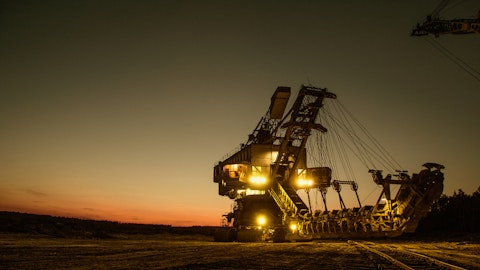United Rentals, Inc. (NYSE:URI) Q4 2022 Earnings Call Transcript January 26, 2023
Operator: Good morning, and welcome to the United Rentals Investor Conference Call. Please be advised that this call is being recorded. Before we begin, please note that the company’s press release, comments made on today’s call and responses to your questions contain forward-looking statements. The company’s business and operations are subject to a variety of risks and uncertainties, many of which are beyond its control, and consequently, actual results may differ materially from those projected. A summary of these uncertainties is included in the Safe Harbor statement contained in the company’s press release. For a complete description of these and other possible risks, please refer to the company’s annual report on Form 10-K for the year ended December 31, 2022, and as well as to subsequent filings with the SEC.
You can access these filings on the company’s website at www.unitedrentals.com. Please note that United Rentals has no obligation and makes no commitment to update or publicly release any revisions to forward-looking statements in order to reflect new information or subsequent events, circumstances or changes in expectations. You should also note that the company’s press release and today’s call include references to non-GAAP terms, such as free cash flow, adjusted EPS, EBITDA and adjusted EBITDA. Please refer to the back of the company’s recent investor presentations to see the reconciliation from each non-GAAP financial measure to the most comparable GAAP financial measure. Speaking today for United Rentals is Matt Flannery, President and Chief Executive Officer; and Ted Grace, Chief Financial Officer.
I will now turn the call over to Mr. Flannery. Mr. Flannery, you may begin.
Matt Flannery: Thank you, operator, and good morning everyone. Thanks for joining our call. Yesterday we reported record fourth quarter results to cap the best full-year financial performance in our history. And we definitely raised the bar in 2022 and we intend to raise it again in 2023. We’re moving forward with a larger sales and service team, a more expansive footprint and a fleet that’s significantly larger than a year ago, and that’s a lot of tailwind at our back in another year of high demand. And I’ll start with a recap of fourth quarter results, which kept us on a strong trajectory. We grew both rental revenue and total revenue by a solid 19% compared with fourth quarter last year. And we grew adjusted EBITDA by 26% with a 280 basis point improvement in margin, and that brought our margin to 50% in the quarter, and that came in at a very strong flow through of 65%.
We also continued to generate significant cash. For the full year, we delivered $1.76 billion of free cash flow, and that’s after investing over $3.4 billion in fleet. And none of this would have been possible without our people. First off, as you know, our top priority is always safety. And our team delivered another first-class recordable rate in 2022 in a year when we onboarded over 6,000 new employees. On the financial side, you can look at every metric I just mentioned and see the quality of Team United behind the result. For example, our revenue growth comes from keeping our customers front and center in the field. Our people are laser-focused on helping our customers succeed. And our flow-through comes from the team’s ability to leverage our growth and maintain good cost discipline.
Inflation was a factor, but that didn’t stop us from delivering very good margins. We also reported a record return on invested capital of 12.7% at year-end. And on the ESG front, we made good progress with sustainability, including new investments in zero-emission vehicles and fleet. And the customer adoption of our new emissions tracking tool has been excellent. This is the technology we launched on our total control platform, and it’s an industry first. Another highlight of the quarter was the Ahern acquisition, and I’m pleased to say the integration is going very well. We closed the deal on December 7. And then by the 16th, our new team members were already operating with the rest of the company on the same technology system. And this means our branches are sharing fleet and customer information seamlessly.
One of the main reasons we like M&A is the capacity we gain. And that comes in three forms: people, fleet and facilities. And we always focus on the people first, because it’s critical to get that right. And we’re really bullish about the talent we onboarded in this acquisition. We had over 100 of the Ahern managers at our Annual Meeting earlier this month, and they fit like a hand in glove. And they’re excited to be part of United and they’re raring to go. Now we’re focused on optimizing the fleet and facilities. We’re running on schedule, and it’s boosting our resources at an ideal time to capture share. The diversity of demand that we pointed to a year ago turned out to be a major tailwind in our operating environment, and that continues to be true.
And I’ll share some fourth quarter data to underscore how we translated this opportunity into top-line growth. Demand in our key verticals was broad-based, with total construction up 19% year-over-year and non-res up 22%; and industrial, up 11%. We leaned into that opportunity across the board and grew rental revenue by solid double digits in all of our gen rent regions as well as all of our specialty businesses. Our specialty segment delivered another strong performance with an 18% increase in rental revenue year-over-year. And it’s notable that every line of business in that segment reported solid gain led by our mobile storage business. Our greenfield investments in specialty are highly strategic and they’re targeted by geography and line of business to generate attractive returns.
And we opened 35 of these locations in the past 12 months, and our plan calls for at least another 40 cold starts in 2023. So that brings us to 2023. So there are plenty of reasons to feel confident about our operating environment. We have terrific internal and external momentum with good visibility into revenue. And the team’s done a great job of driving strong fleet productivity to help offset the cost inflation we’ve experienced. Contractor backlogs are growing, and not surprisingly, the employment reports indicate that U.S. contractors continue to be in expansion mode. Industry indicators like Dodge Momentum Index show healthy growth trends in commercial construction, and this includes the planning trends for future projects. There’s also a strong institutional component to the trends which we see in our business.
And a number of our multi-year projects are in sectors like healthcare and education. And the industrial indicators like the PMI still have room for improvement. But the construction activity and manufacturing’s going strong. We’re winning business on a wide range of new plant construction including automotive and batteries, semiconductors and petrochem. And importantly, our own survey shows that customer sentiment remains strong with the majority of our customers point to growth over the next 12 months. One final indicator of market strength and an important one was at our annual management meeting. We had over 2,000 field leaders with us in Houston two weeks ago, and their take was extremely positive. And I’m throwing that into the mix because this is coming directly from people on the front lines.
We took all this into consideration when we developed our 2023 guidance. And as you saw yesterday, we expect our revenue and adjusted EBITDA to hit new high water marks, including free cash flow of more than $2.1 billion, while our return on invested capital should be another milestone for us. In addition to the capacity we carried into January, we plan to invest more than $3.4 billion in gross CapEx this year. And at the same time, we’ll continue to take advantage of a strong used equipment market to optimize our fleet. Longer-term outlook for our industry continues to be very favorable driven by several tailwinds that we believe are largely independent of macro conditions. And we’ve talked about these before, things like infrastructure spending, the Inflation Reduction Act and the return of manufacturing to North America as well as investments in both energy and power.
Now, before I wrap up, I want to mention two important announcements we made yesterday regarding capital allocation. First off, we’re reactivating the $1.25 billion share repurchase program that we pause when we announce the Ahern deal. We plan to buy back $1 billion of stock this year. And we’ll also be instituting quarterly dividends for our shareholders, totaling $5.92 per share this year. These two decisions underscore our confidence in the durability of our cash generation and the strength of our balance sheet. And together, they’ll return $1.4 billion of capital to our shareholders in 2023. So to come full circle, 2022 was a demand environment that through the door wide open for a record year and we ran with it. But to quote Babe Ruth, we also know that yesterday’s home runs don’t win tomorrow’s games.
So now it’s onwards and upwards. 2023 is officially the start of the next quarter century in business for United Rentals, and by all accounts, this will be another memorable year. So with that, I’ll ask Ted to cover the results and then we’ll go to Q&A. Ted, over to you.
Ted Grace: Thanks, Matt, and good morning, everyone. As you saw in the results we reported last night, the team did a great job delivering across the board, both in the quarter and for the full year. And importantly, as you can see in our guidance, we expect these trends to continue in 2023. Combined with the enhancements to our capital allocation strategy that we’ve announced this quarter, we are confident that we will continue to drive meaningful long-term value creation for our shareholders. I’ll dig into this more in a bit, but first, let’s dive into the quarter. Fourth quarter rental revenue was a record $2.74 billion. That’s an increase of $435 million or nearly 19% year-over-year. Within rental revenue, OER increased by $354 million or 18.6%.
Our fleet average €“ our average fleet size increased by 14.2%, which provided a $270 million benefit to revenue and fleet productivity increased by healthy 5.9%, which added another $113 million. This was partially offset by our usual fleet inflation of 1.5% or roughly $29 million. Also within rental, ancillary revenues were higher by $81 million or 23.1% year-over-year. While re-rent was essentially flat. Outside of rental, fourth quarter used sales increased by roughly 26% to $409 million as we sold some fleet we’ve held back on selling earlier in the year. To help accomplish this, we brought in our channel mix for used sales in Q4 to something closer to normalized levels. The net of this was our adjusted use margins increased by 940 basis points year-over-year to 61.6% supported by strong pricing.
Let’s move to EBITDA. Adjusted EBITDA for the quarter was $1.65 billion, another record and an increase of $338 million or 25.8% year-on-year. The dollar change included a $291 million increase from rental within, which OER contributed $256 million. Ancillary added $34 million and re-rent was up $1 million. Outside of rental, used sales added about $83 million to adjusted EBITDA, while other non-rental lines of businesses contributed another $18 million. SG&A was a $54 million headwind to adjusted EBITDA due primarily to higher commissions and the continued normalization of certain discretionary costs. As a percentage of sales, however, SG&A was down slightly year-over-year. Looking at fourth quarter profitability, our adjusted EBITDA margin increased 280 basis points to 50.0%.

weerasak saeku/Shutterstock.com
Excluding the benefit of used sales, flow-through was in line with recent quarters at a healthy 59%. I’ll add that within the fourth quarter results, in the roughly three weeks we owned Ahern, the business contributed about $54 million of total revenue, the vast majority of which was rental and roughly $20 million of EBITDA. And finally, fourth quarter adjusted EPS was $9.74 per share. That’s an increase of $2.35 per share or almost 32% year-on-year. Turning to CapEx. Fourth quarter gross rental CapEx was $980 million, and net rental CapEx was $571 million. This represents an increase of $205 million in net CapEx year-over-year, which positions us well for the growth we see in 2023. Now, let’s look at return on invested capital and free cash flow.
ROIC was another highlight at a record 12.7% on a trailing 12-month basis. That’s up 50 basis points sequentially and an increase of 240 basis points year-on-year. Free cash flow also continues to be very strong, with the year coming in at $1.76 billion or a free cash margin of better than 15%, all while continuing to fund growth. Turning to the balance sheet. Our leverage ratio at the end of the quarter was 2.0 times on an as-reported basis, including the impact of the Ahern acquisition. More importantly, on a pro forma basis, our year-end leverage ratio was flat sequentially at 1.9 times. And finally, our liquidity at the end of the quarter was a very robust $2.9 billion with no long-term note maturities until 2027. Now, let’s look forward and talk about our 2023 guidance.
Total revenue is expected in the range of $13.7 billion to $14.2 billion, implying full year growth of about 20% at midpoint and pro forma growth of roughly 12%. This increase is supported by the momentum we’ve carried into the New Year, particularly within rental revenue and the contribution from Ahern. Within total revenue, I’ll note that our used sales guidance is implied at $1.3 billion, with the expectation that we’ll sell roughly $2 billion of OEC. This 35% increase in used sales year-over-year primarily reflects two things. First, is the normalization of our used sales as the supply chain continues to improve. And second, a substantially larger fleet, including the addition of Ahern to our business. We remain focused on efficiently converting this growth to our bottom line.
Our adjusted EBITDA range is $6.6 billion to $6.85 billion. On an as-reported basis, including the impact of Ahern, at midpoint, this implies roughly flat full year adjusted EBITDA margins and flow-through of about 48%. On a pro forma basis, however, which we think is the more appropriate way to think about it, our guidance would imply at roughly 80 basis points of margin expansion and flow through in the mid-50s. On the fleet side, our initial gross CapEx guidance is $3.3 billion to $3.55 billion, with net CapEx of $2 billion to $2.25 billion. And finally, our free cash guidance is $2.1 billion to $2.35 billion. To be clear, this is before dividends and repurchases. Assuming these two factors are a use of cash of roughly $1.4 billion that leaves $825 million of remaining free cash flow to fund additional growth or reduce net debt.
Now before we go to Q&A, I want to make some additional comments on our updated capital allocation strategy. Specifically around our plans to return excess cash to our investors. As you heard Matt say, we are very pleased to be adding a dividend program to our mix. Based on an initial yield of 1.5%, we expect to pay $5.92 in dividends per share in 2023. This will translate to approximately $400 million this year or roughly 18% of free cash flow. We expect that our first quarterly dividend payment of $1.48 will be made on February 22, with all four payments expected within the calendar year. Following the transformation of the company over the last decade or so, we feel that it’s the appropriate time to add this last element to our capital return strategy to help drive greater shareholder value.
Not only will this help expand the universe of potential investors, we expect that it will also provide another means of enhancing total returns for our investors over time. It also reflects the confidence we have in our operating model to consistently generate considerable excess free cash flow after investing in growth. We’re also very pleased to announce the restart of our share repurchase program, which we paused in November with the announcement of Ahern. The restart is probably a bit ahead of schedule, but the integration is off to a great start and the decision is well supported by the financial performance we expect this year. It’s our intention to repurchase $1 billion of the $1.25 billion authorization in calendar 2023. As Matt said, these two programs combined, should return approximately $1.4 billion to our shareholders this year or about $20 per share at the same time that we continue to see substantial growth in our earnings.
Finally, I want to be clear that these announcements are being made in the context of our continued commitment to a disciplined balance sheet strategy. Our financial strength has served the company and its shareholders very well, and we’re not planning any changes there. So with that, we’ll turn to Q&A. Operator, could you please open the line?
See also 21 Biggest Airports in the World and 10 Stocks with Biggest Buybacks.
Q&A Session
Follow United Rentals Inc. (NYSE:URI)
Follow United Rentals Inc. (NYSE:URI)
Receive real-time insider trading and news alerts
Operator: We’ll take our first question from David Raso with Evercore ISI.
David Raso: Hi, thank you for the time. Two questions. One, where there’s some worry by investors and another where there’s a clear cementing of a structural improvement on people’s minds about the business model. First, in the area of , equipment availability, I think, Matt, you had mentioned earlier about maybe taking some market share this year. Can you let us know what you’re seeing and hearing regarding competitors and even include OEM dealers, rental fleets in this comment? What are you hearing about their incremental ability to get equipment? What are you hearing about their adding fleet for the year? Just the overall availability from that side? And what are your equipment suppliers suggesting about increased availability versus last year? And I’ll follow up the other question.
Matt Flannery: Yes, sure. So we €“ it’s still a tight market. I’m hoping it will be a little better as far as delivery slots than we got last year. But we don’t expect the supply chain to be fully back to normal this year, maybe to the back half, but to be fair, I thought maybe the back half of last year would have and we still saw slippage. There are some niche products that are being quoted out to 2024. Now that’s the exception, not the rule. But I think that that kind of underlies another year of some supply chain challenges. And we’re mitigating that by, as you saw, we brought in some fleet in Q4, and you’ll probably see us do a little bit more in Q1 than usual to make sure we’re ready for the build season. And then from there, we’ll adjust according to demand appropriately.
So, I think there will still be a little bit of a challenge. I think our vendors work hard, David, to get us a fleet they did in 2022, and we think they’ll work hard to get this number. I’m not seeing a remedy to the supply chain challenges.
David Raso: Yes. Can I asked one question related to what you just said the first quarter, a little larger than normal. I’m just curious, just the cadence for the CapEx for the year, I’m talking gross, the 3.425 midpoint. Can you give us some sense of cadence is €“ I know you pulled forward, but on the idea of roughly flat gross for the year. Is the down quarter more the fourth quarter because of the pull forward in the fourth quarter?
Matt Flannery: That’s our expectation as we sit here today, David. What I really wanted to refer to is you’ll prop because it’s the one that we feel pretty sure of is that you’ll probably see us do more about 20% of our capital spend here in Q1 as opposed to maybe in a standard year, it would be 12% to 15%. And that pull forward is really just to get ready for the spring season, and making sure specifically in these high time categories that have been the most challenged in the supply chain that we’re ready to respond to the customers. Is that really what I was referring to as far as the cadence for the rest of the year, Q2 and Q3 really will depend on how fast we’re absorbing the fleet that we brought in as well as how well we’re doing with the Ahern’s fleet. So, we’ll adjust as we had the past three years accordingly.
David Raso: It’s pretty interesting. That’s taking about $1.6 billion of fleet in the fourth quarter and the first quarter when you combine the two. I assume you’re seeing project backlogs that are really focused on we need this equipment for certain projects. This is not a presumption of demand? I mean, is that just a pretty big first quarter number to follow the fourth quarter, is that
Matt Flannery: Yes, it absolutely David. And that is because we see the underlying demand, and we’ve talked a lot, right, in the last quarter as well about the mega projects. So they’ll require a lot of this high time utilization assets. Additionally, we’ll also get more to a more normal cadence of used sales than we have. We held back, and we hope we don’t have through this year. We’re planning on selling about 35% more use sales to get back to a normal fleet rotation. So that some of that capital will be to make sure that we have the ability to sell, and we don’t have the team losing confidence in their ability to rotate fleet out so that we can still meet demand.
David Raso: Just a strong €“ obviously, you’re seeing very strong demand in the year is going to start very strongly with that much fleet over the six months even with the used sales as well. Second question. So if we do the dividend, we do the repo if you look at the guide, it implies net debt-to-EBITDA at the end of the year at 1.55 , which is almost a half turn below the low end of your range. Can you give us a sense of the capital allocation, how we should think about that? Where would you be comfortable with the leverage? Or should we think of it as you want to get the leverage back to the low end of the range and thus, M&A?
Ted Grace: David, this is Ted. I’ll take that one. There’s no change to that longer-term framework we’ve provided of two times to three times being that optimal level. We’d always said there was nothing religious about the low end. And so living there for some amount of time to us is something that is consistent with what we’ve articulated. The idea really would be the kind of stockpile dry powder for potential growth opportunities. If we were to kind of decide to live in a different ZIP code entirely, we would certainly update €“ the Street. But certainly for the immediate future, we’re comfortable at these levels.
David Raso: I appreciate it guys. Thanks for the time.
Ted Grace: Thanks, David.
Operator: Thank you. Our next question comes from Steven Fisher of UBS.





